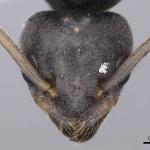Tapinoma ambiguum Emery, 1925.
Tapinoma madeirense Forel, 1895.
Previously known as T. ambiguum and then briefly as T. madeirense. Workers of this species look superficially like the common black garden ant Lasius niger, but can be distinguished in the field by their behaviour when disturbed. On warm days the small black workers (2.6-4.2 mm) dart around very quickly and aggressively with their gasters slightly raised. Under magnification they completely lack the standing body and appendage hairs of L. niger, the petiole node is also inconspicuous and overhung by the first gastral segment also workers and gynes lack a conical hair-fringed acidopore at the tip of the gaster (instead there is a simple lateral slit).
Naming: There are only two species of Dolichoderine ants native to Britain, T. subboreale iso Seifert 2012 and the very similar T. erraticum iso Seifert 2012. These names should only be used for records where the species has been determined with reference to recent literature. These species have only recently been separated and virtually all British records are still denoted as T. erraticum. Therefore for older reecords or where the species is uncertain the name T. erraticum agg. iso Seifert 2012 should be used. The two species are very difficult to separate, relying on characters such as depth of the clypeal notch and shape of the male genitalia. Little is known about any differences in the biology, ecology and distribution of each species and this would merit further investigation.
The map has very few dots because it is only for records that have been certainly determined as Tapinoma subboreale Seifert, 2012. For a map showing T. erraticum agg. see the T. erraticum page
T. subboreale is confined to the southern counties of England and possibly the Channel Isles. Nests are easily overlooked and often only isolated colonies are found.
The species invariably nests in dry places exposed to the sun, with short vegetation and patches of bare ground.
The gynes of T. subboreale are relatively small (4.5-5.5 mm) in comparison with those of Lasius and the males are a similar size (3.5-5.0 mm). Sexuals are usually found in nests in June and they fly in June or July.
It prefers close cropped or recently burnt sites to dense overgrown vegetation as it requires sufficient insolation to raise its brood. The ants will frequently move their nests to more favourable sites if required. Colonies are usually quite small containing a few hundred workers and many queens, although occasionally very populous colonies do occur. Nests are shallowly constructed in soil, occasionally under stones, on banks or in dry peat or moss clumps. The ants frequently raise small solaria of soil and vegetation fragments, often around some supporting vegetation.
Tapinoma subboreale is chiefly carnivorous, taking small invertebrates and carrion. It has also been reported to occasionally tend Homoptera for their honeydew. The workers are rarely found on cool overcast days but are very active in full sunshine.
No parasitic ants are known to be associated with T. subboreale in Britain.
2021


